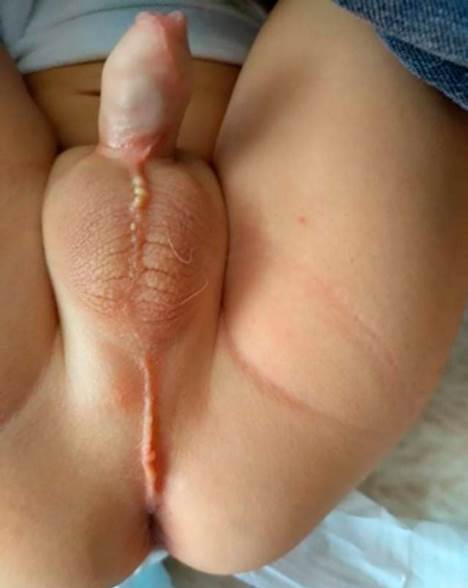A healthy 6-month-old boy was brought to a routine visit to the family physician (FF). The physical examination showed a thickened perineal raphe with several millimetric ovoid lesions from the scrotum to the perineum in the midline (Fig. 1). The remaining physical examination was unremarkable with no associated local inflammatory signs or other visible signs of anorectal malformations. Scrotal ultrasonography revealed retractable testicles, with no other findings. In his last visit to FF, at 18 months old, the lesions remained stable, with a slight increase in the thickening of the perineal raphe and small-sized cysts, located predominantly in the scrotal region (Fig. 2). The infant was referred to a Pediatric surgeon where the diagnosis of median raphe cysts (MRCs) was confirmed. Remained the indication for clinical surveillance.
MRCs are uncommon benign congenital lesions of the male genitalia, present anywhere from the perianal region to the scrotum and distal penis, being considered congenital defects in the embryologic development.1,2 Diagnosis in children is rare, although probably underreported considering up to 75% are asymptomatic.1 According to literature, most MRCs are found along the penile shaft and only a few cases report scrotum or perineal raphe cysts.3 Once they can mimic scrotal pearls in infants with anorectal malformations, a careful physical examination of the anogenital region should be performed.4 These cysts may grow with the child and clinical symptoms are more common in adulthood, due to infections1,4,5 or urinary symptoms like difficulty in voiding, hematuria, hematospermia, or sexual symptoms.1,6 Treatment for MRCs surgical excision in symptomatic patients. Conservative management could be considered for small asymptomatic lesions since histologic studies report no malignant potentiality.3 Spontaneous regression was barely reported.1 It is important that pediatricians and FF recognize these lesions and their management to tranquilize and provide the appropriate information to parents to plan an adequate treatment.

















